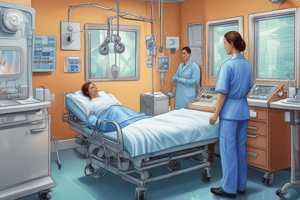Podcast
Questions and Answers
Which of the following symptoms is not commonly associated with type 2 diabetes?
Which of the following symptoms is not commonly associated with type 2 diabetes?
- Visual changes
- Prolonged wound healing
- Recurrent infections
- Increased hunger (correct)
What is the main risk associated with prediabetes?
What is the main risk associated with prediabetes?
- Increased risk of type 2 diabetes within 10 years (correct)
- Development of gestational diabetes
- Reversal of blood glucose levels
- Immediate symptoms of diabetes
What is the purpose of performing an oral glucose tolerance test during pregnancy?
What is the purpose of performing an oral glucose tolerance test during pregnancy?
- To assess overall nutritional status
- To screen for gestational diabetes (correct)
- To diagnose type 1 diabetes
- To determine fetal growth rate
Which method is not used for diagnosing diabetes?
Which method is not used for diagnosing diabetes?
What is the main goal of diabetes management?
What is the main goal of diabetes management?
Which type of insulin is specifically used to manage blood sugar levels at mealtimes?
Which type of insulin is specifically used to manage blood sugar levels at mealtimes?
What occurs in patients with prediabetes concerning long-term damage?
What occurs in patients with prediabetes concerning long-term damage?
Which statement about exogenous insulin is true?
Which statement about exogenous insulin is true?
What is the primary insulin management regimen preferred for adults with Type 1 Diabetes Mellitus (T1DM)?
What is the primary insulin management regimen preferred for adults with Type 1 Diabetes Mellitus (T1DM)?
Which of the following factors should be considered when tailoring insulin regimens for individuals with T1DM?
Which of the following factors should be considered when tailoring insulin regimens for individuals with T1DM?
What is the main goal for diabetes management in adults with T1DM?
What is the main goal for diabetes management in adults with T1DM?
Which therapy may be considered if glycemic targets are not met with optimized multiple daily injections?
Which therapy may be considered if glycemic targets are not met with optimized multiple daily injections?
What should all T1DM patients be counseled about regarding insulin therapy?
What should all T1DM patients be counseled about regarding insulin therapy?
Continuous glucose monitoring is recommended for which group of patients?
Continuous glucose monitoring is recommended for which group of patients?
What are the characteristics of insulin preparations used for T1DM?
What are the characteristics of insulin preparations used for T1DM?
Which of the following is a characteristic of continuous subcutaneous insulin infusion (CSII)?
Which of the following is a characteristic of continuous subcutaneous insulin infusion (CSII)?
Which of the following is a direct effect of regular exercise in diabetes management?
Which of the following is a direct effect of regular exercise in diabetes management?
What factors influence the frequency of self-monitoring of blood glucose (SMBG)?
What factors influence the frequency of self-monitoring of blood glucose (SMBG)?
Which patient might be considered for bariatric surgery as part of their diabetes management?
Which patient might be considered for bariatric surgery as part of their diabetes management?
What is a primary goal of diabetes self-management education?
What is a primary goal of diabetes self-management education?
What is a characteristic of diabetic ketoacidosis (DKA)?
What is a characteristic of diabetic ketoacidosis (DKA)?
Which nursing responsibility is essential for a patient receiving insulin therapy?
Which nursing responsibility is essential for a patient receiving insulin therapy?
What type of diabetes management might pancreas transplantation be considered for?
What type of diabetes management might pancreas transplantation be considered for?
What is a consequence of increased insulin sensitivity due to exercise?
What is a consequence of increased insulin sensitivity due to exercise?
Flashcards
Type 2 Diabetes Manifestations
Type 2 Diabetes Manifestations
Type 2 diabetes symptoms are often subtle and include fatigue, recurrent infections, vaginal yeast infections, slow-healing wounds, and vision changes.
Prediabetes
Prediabetes
A condition with higher-than-normal blood sugar, but not high enough for a diabetes diagnosis.
Prediabetes Long-Term Damage
Prediabetes Long-Term Damage
Heart and blood vessel damage may already be present in prediabetes patients.
Gestational Diabetes
Gestational Diabetes
Signup and view all the flashcards
Gestational Diabetes Postpartum Risk
Gestational Diabetes Postpartum Risk
Signup and view all the flashcards
Diabetes Diagnosis Methods
Diabetes Diagnosis Methods
Signup and view all the flashcards
Diabetes Management Goals
Diabetes Management Goals
Signup and view all the flashcards
Insulin Types
Insulin Types
Signup and view all the flashcards
Diabetes Exercise
Diabetes Exercise
Signup and view all the flashcards
Blood Glucose Monitoring
Blood Glucose Monitoring
Signup and view all the flashcards
Bariatric Surgery for Diabetes
Bariatric Surgery for Diabetes
Signup and view all the flashcards
Pancreas Transplantation
Pancreas Transplantation
Signup and view all the flashcards
Insulin Administration (Nursing)
Insulin Administration (Nursing)
Signup and view all the flashcards
Oral/Injectable Agents (Nursing)
Oral/Injectable Agents (Nursing)
Signup and view all the flashcards
Diabetic Ketoacidosis (DKA)
Diabetic Ketoacidosis (DKA)
Signup and view all the flashcards
Diabetes Self-Management Education
Diabetes Self-Management Education
Signup and view all the flashcards
T1DM Insulin Management
T1DM Insulin Management
Signup and view all the flashcards
Insulin Regimen Tailoring
Insulin Regimen Tailoring
Signup and view all the flashcards
Hypoglycemia Risk in T1DM
Hypoglycemia Risk in T1DM
Signup and view all the flashcards
Continuous SC Infusion
Continuous SC Infusion
Signup and view all the flashcards
Continuous Glucose Monitoring
Continuous Glucose Monitoring
Signup and view all the flashcards
Glycemic Balance Goal
Glycemic Balance Goal
Signup and view all the flashcards
Basal-Bolus Insulin Therapy
Basal-Bolus Insulin Therapy
Signup and view all the flashcards
Insulin Therapy for T1DM Diagnosis
Insulin Therapy for T1DM Diagnosis
Signup and view all the flashcards
Study Notes
You People Have No Idea - Care Scenario Notes
- This document is study notes for a Nursing Concepts in Health and Illness III course at McMaster University, Fall 2021.
- It covers diabetes mellitus, including type 1 and type 2, gestational diabetes, prediabetes, and diagnostic studies.
- It also discusses collaborative care, drug therapy, including insulin regimens, oral agents, and noninsulin injectables, and monitoring blood glucose.
- Chronic complications of diabetes, such as macrovascular and microvascular complications, are discussed, including diabetic retinopathy, nephropathy, and neuropathy.
- Acute complications, such as diabetic ketoacidosis (DKA) and hyperosmolar hyperglycemic syndrome (HHS) are discussed.
- Management of diabetes in children and adolescents, including education, glycemic targets, insulin therapy, and complications unique to pediatric populations.
- The role of the nurse in managing diabetes, and patient/family education are also highlighted.
Diabetes Mellitus
- A chronic multisystem disorder of glucose metabolism, related to insulin deficiency or impaired utilization.
- Current theories link causes to genetic, autoimmune, and environmental factors.
Type 1 Diabetes Mellitus
- Typically diagnosed before age 40, with 40% of cases diagnosed before 20 years old.
- Characterized by the body's own T cells attacking and destroying pancreatic cells, the source of insulin.
- Rapid-onset symptoms: polyuria, polydipsia, and polyphagia (caused by hyperglycemia).
- Requires insulin therapy to sustain life.
- Diabetic ketoacidosis (DKA) is a life-threatening complication without insulin.
Type 2 Diabetes Mellitus
- Accounts for over 90% of cases.
- Often associated with insufficient or poorly used insulin.
- Obesity, specifically abdominal and visceral adiposity, is the most significant risk factor.
- Symptoms are generally less acute than in type 1.
- Common symptoms include fatigue, recurrent infections, yeast infections, slow wound healing, and visual changes.
Prediabetes
- Blood glucose levels are higher than normal but not yet high enough for a diagnosis of diabetes.
- Individuals with prediabetes are at high risk for developing type 2 diabetes within 10 years.
- Preventive measures are crucial.
Gestational Diabetes
- Develops during pregnancy, typically screened for between 24-28 weeks gestation.
- Often resolves after pregnancy, but there is a higher risk of developing type 2 diabetes later in life.
Diagnostic Studies
- Fasting plasma glucose test
- Random plasma glucose test
- 2-hour oral glucose tolerance test
- A1C test
Collaborative Care
- Reducing symptoms and promoting well-being
- Preventing acute complications of hyperglycemia.
- Preventing/delaying long-term complications (macrovascular and microvascular.)
Drug Therapy: Insulin
- Exogenous insulin is needed when a patient has inadequate insulin production.
- Insulins are categorized as short-acting (bolus) and long-acting (basal).
- Bolus insulin targets postprandial hyperglycemia; basal insulin maintains background levels throughout the day.
- Several regimens are used depending on patient needs.
Oral Agents and Non-Insulin Injectable Agents
- Metformin is a common oral agent used for type 2 diabetes. Works by reducing glucose production in the liver.
- Sulfonylureas and Meglitinides increase insulin production from the pancreas.
- a-Glucosidase inhibitors slow carbohydrate absorption.
- Thiazolidinediones are effective for insulin resistance but have severe adverse effects.
- Dipeptidyl peptidase IV (DPP-4) inhibitors slow the degradation of GLP-1, resulting in improved glycemic control
Studying That Suits You
Use AI to generate personalized quizzes and flashcards to suit your learning preferences.
Related Documents
Description
This quiz covers essential topics in Nursing Concepts related to diabetes mellitus, including types 1 and 2, gestational diabetes, and prediabetes. It addresses collaborative care, drug therapies, and the management of chronic and acute complications of diabetes. The role of nursing in patient education and care for children and adolescents with diabetes is also discussed.




